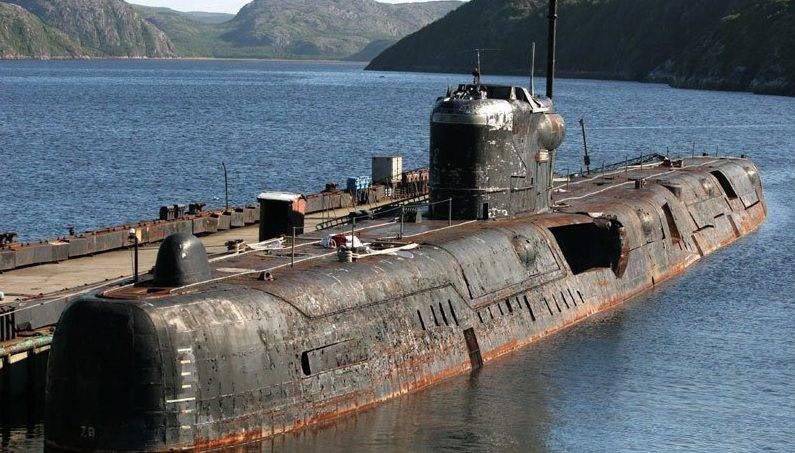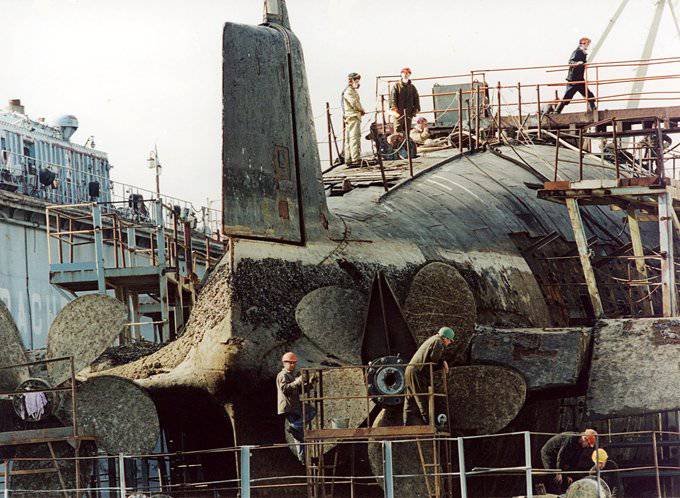New facility for nuclear safety Pacific Fleet

Recall that in August, 85, during the reloading of nuclear fuel into the K-431 submarine reactors (675 project), the confluence of circumstances led to a thermal explosion of the reactor. The explosion killed ten people and a few dozen others were seriously injured in extinguishing the fire and eliminating the consequences of the accident. Just a few months after the explosion at K-431, in December of the same 1985 of the year, the reactor core was drained on the K-314 submarine (project 671), which led to partial melting of the fuel assemblies and parts of the reactor itself. The power plant had to be stopped as a matter of urgency, but by this time it had received such damage that it could not be repaired. In addition, the boat is already pretty much "fonila".
In accordance with the rules at the time, the injured boats were sent to sludge and decontaminated polluted coastal areas. At the same time, the development of options for the disposal or burial of boats began, but soon the USSR collapsed and buried all the projects considered under its rubble. As a result, the Pacific Fleet had to independently monitor the state of emergency boats and hope that the state will some day reach for the elimination of this nuclear threat. But in addition to the K-431 and K-314 in the sludge was still a lot of decommissioned nuclear submarines. In such a suspension, the Pacific Fleet spent almost 15 years, after which the situation began to gradually clear up. First, in the middle of the two thousandths, the entire fleet infrastructure related to nuclear technology was “taken away” from the Navy and transferred to Rosatom. A little later, in 2008, the Government of Russia instructed the Far Eastern Center for the Management of Spent Nuclear Fuel and Radioactive Waste "DalRAO" to create in the Rogue Bay an isolation point for emergency submarines.
It is clear that isolating an emergency boat, to put it mildly, is not easy. An underwater ship with a displacement of several thousand tons must be pulled out of the water and installed on a solid foundation. In addition, all this will have to do in conditions of high radioactive background and with the risk of destruction of the design of the emergency boat. The latter fact, by the way, served as one of the reasons for the acceleration of work in the field of disposal of damaged submarines. Being on the water, such a boat in the event of an adverse development of the situation is much more dangerous than if it were in an isolated complex. With the K-431 and K-314 boats they arrived according to the already worked out scheme: they sealed and delivered to the Zvezda ship-repair factory (the city of Bolshoy Kamen). They made a boat out of the boat. three-compartment unit - only the reactor compartment and two adjacent ones were left from the boat. The rest with all precautions disposed of.

Simultaneously with the cutting of emergency boats in the Razboinik Bay, the construction of the Isolation Point began. A section of rock was cut down, in place of which a horizontal flat platform was cleared. In addition, a ditch with a size of 250 on 60 meters and a depth of about five was dug on this site. A channel was also cut down for communication with the sea. In the channel set the shutter. In June of last year, the first phase of the Isolation Point was completed - Shelter No.1. At the same time, a three-compartment unit from the “175 order” was delivered to the site. In November, the second stage was completed (Shelter No.2), and already in the middle of this year, the Isolation Point will be put into operation. Soon after the construction of the second shelter was completed, a three-compartment “610 order” unit was placed there. By the summer of this year, a platform will be completed for the simultaneous storage of hundreds of single-compartment units. Thus, at the Isolation Point, shipyards will be brought three-compartment blocks and installed in shelters. There, all unnecessary parts will be cut off from the reactor compartments, after which they will be transferred to the storage site. It is noteworthy that the Far Eastern Insulation Station can carry out all the necessary work from receiving the "three-compartment" to the storage of the remaining reactor compartments. For example, in the Northern Fleet, ready-made single-end units are brought to the Isolation Point.
Currently, two units with reactor compartments are already in production and another fifty are afloat and are waiting for their turn. “DalRAO”, predicting the amount of future work, now claims that in the very near future it will be necessary to recruit another two or two and a half hundred workers in various specialties. And this kind of work can be very attractive for potential employees: according to the management of the organization, the average salary at the company last year reached 35 thousand rubles, a considerable amount by Far Eastern standards. But the main thing in the work of the Isolation Point is that when working on emergency boats, no worker received an exposure dose exceeding the allowable one. It means that at the enterprise the case is placed in such a way that all safety rules are observed, workers treat the atom, as they say, on “you” and he has no reason to “be offended” at the wrong attitude.
Information